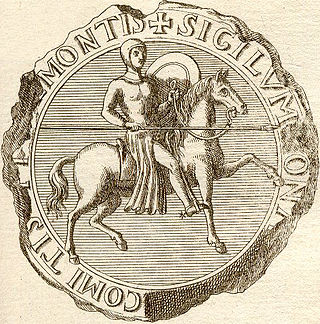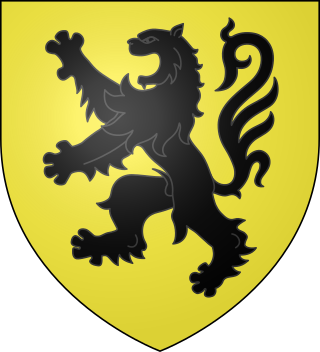
Geoffrey II was Duke of Brittany and Earl of Richmond between 1181 and 1186, through his marriage to Constance, Duchess of Brittany. Geoffrey was the fourth of five sons of Henry II of England and Eleanor of Aquitaine.

Arthur I was 4th Earl of Richmond and Duke of Brittany between 1196 and 1203. He was the posthumous son of Geoffrey II, Duke of Brittany, and Constance, Duchess of Brittany. Through Geoffrey, Arthur was the grandson of Henry II, King of England and Eleanor of Aquitaine, and the nephew of King Richard I of England.

The Duchy of Brittany was a medieval feudal state that existed between approximately 939 and 1547. Its territory covered the northwestern peninsula of Europe, bordered by the Atlantic Ocean to the west, and the English Channel to the north. It was also less definitively bordered by the river Loire to the south, and Normandy, and other French provinces, to the east. The Duchy was established after the expulsion of Viking armies from the region around 939. The Duchy, in the 10th and 11th centuries, was politically unstable, with the dukes holding only limited power outside their own personal lands. The Duchy had mixed relationships with the neighbouring Duchy of Normandy, sometimes allying itself with Normandy, and at other times, such as the Breton–Norman War, entering into open conflict.

Peter I, also known as Peter Mauclerc and Peter of Dreux, reigned as Duke of Brittany alongside his wife Alix from 1213 to 1221, and was regent of the duchy for his minor son John I from 1221 to 1237. As duke he was also 1st Earl of Richmond from 1218 to 1235.
Constance was Duchess of Brittany from 1166 to her death in 1201 and Countess of Richmond from 1171 to 1201. Constance was the daughter of Duke Conan IV by his wife, Margaret of Huntingdon, a sister of the Scottish kings Malcolm IV and William I.

Eleanor, Fair Maid of Brittany, also known as Damsel of Brittany, Pearl of Brittany, or Beauty of Brittany, was the eldest daughter of Geoffrey II, Duke of Brittany, and Constance, Duchess of Brittany. Her father, Geoffrey, was the fourth son of Henry II, King of England.

Conan IV, called the Young, was the Duke of Brittany from 1156 to 1166. He was the son of Bertha, Duchess of Brittany, and her first husband, Alan, Earl of Richmond. Conan IV was his father's heir as Earl of Richmond and his mother's heir as Duke of Brittany. Conan and his daughter Constance would be the only representatives of the House of Penthièvre to rule Brittany.

Alix was Duchess of Brittany from 1203 until her death. She was also Countess of Richmond in the peerage of England.

The now-extinct title of Earl of Richmond was created many times in the Peerage of England. The earldom of Richmond was initially held by various Breton nobles; sometimes the holder was the Breton duke himself, including one member of the cadet branch of the French Capetian dynasty. The historical ties between the Duchy of Brittany and this English earldom were maintained ceremonially by the Breton dukes even after England ceased to recognize the Breton dukes as earls of England and those dukes rendered homage to the King of France, rather than the English crown. It was then held either by members of the English royal families of Plantagenet and Tudor, or English nobles closely associated with the English crown. It was eventually merged into the English crown during the reign of Henry VII of England and has been recreated as a Dukedom.
The counts of Nantes were originally the Frankish rulers of the Nantais under the Carolingians and eventually a capital city of the Duchy of Brittany. Their county served as a march against the Bretons of the Vannetais. Carolingian rulers would sometimes attack Brittany through the region of the Vannetais, making Nantes a strategic asset. In the mid-ninth century, the county finally fell to the Bretons and the title became a subsidiary title of the Breton rulers. The control of the title by the Breton dukes figured prominently in the history of the duchy. The County of Nantes was given to Hoel, a disinherited son of a duke. He lost the countship due to a popular uprising. That uprising presented an opportunity for King Henry II of England to attack the Breton duke. In the treaty ending their conflicts, the Breton duke awarded the county to Henry II.
Margaret of Huntingdon was a Scottish princess and Duchess of Brittany. She was the sister of Scottish kings Malcolm IV and William I, wife of Conan IV, Duke of Brittany, and the mother of Constance, Duchess of Brittany. Her second husband was Humphrey de Bohun, hereditary Constable of England. Following her second marriage, Margaret styled herself as the Countess of Hereford.

The Honour of Richmond was a feudal barony in what is now mainly North Yorkshire, England. The honour was two tiers below Yorkshire, the middle tier being the North Riding.
Catherine of Thouars was the daughter of Constance, suo jure Duchess of Brittany and Countess of Richmond, and her third husband Guy of Thouars. She was the first wife of Andrew III, Baron of Vitré.
Alan III de Rohan, was the son of Alan II, Viscount of Rohan. He was the 3rd Viscount of Rohan and Lord of Corlay.

Herve I of Léon was the first Lord of Léon, the founding member of the junior branch of the Léon family.
Andrew II of Vitré was Baron de Vitré from 1173 to 1211.

Villeneuve Abbey, dedicated to Our Lady, was a Cistercian monastery at the present-day Les Sorinières, near Nantes in Pays de la Loire, France, founded in 1201 and dissolved in 1790, during the French Revolution.

Buzay Abbey, dedicated to Our Lady, was a Cistercian Abbey at Rouans in Pays de la Loire, France, formerly in Brittany, founded in 1135 and dissolved in 1790.












